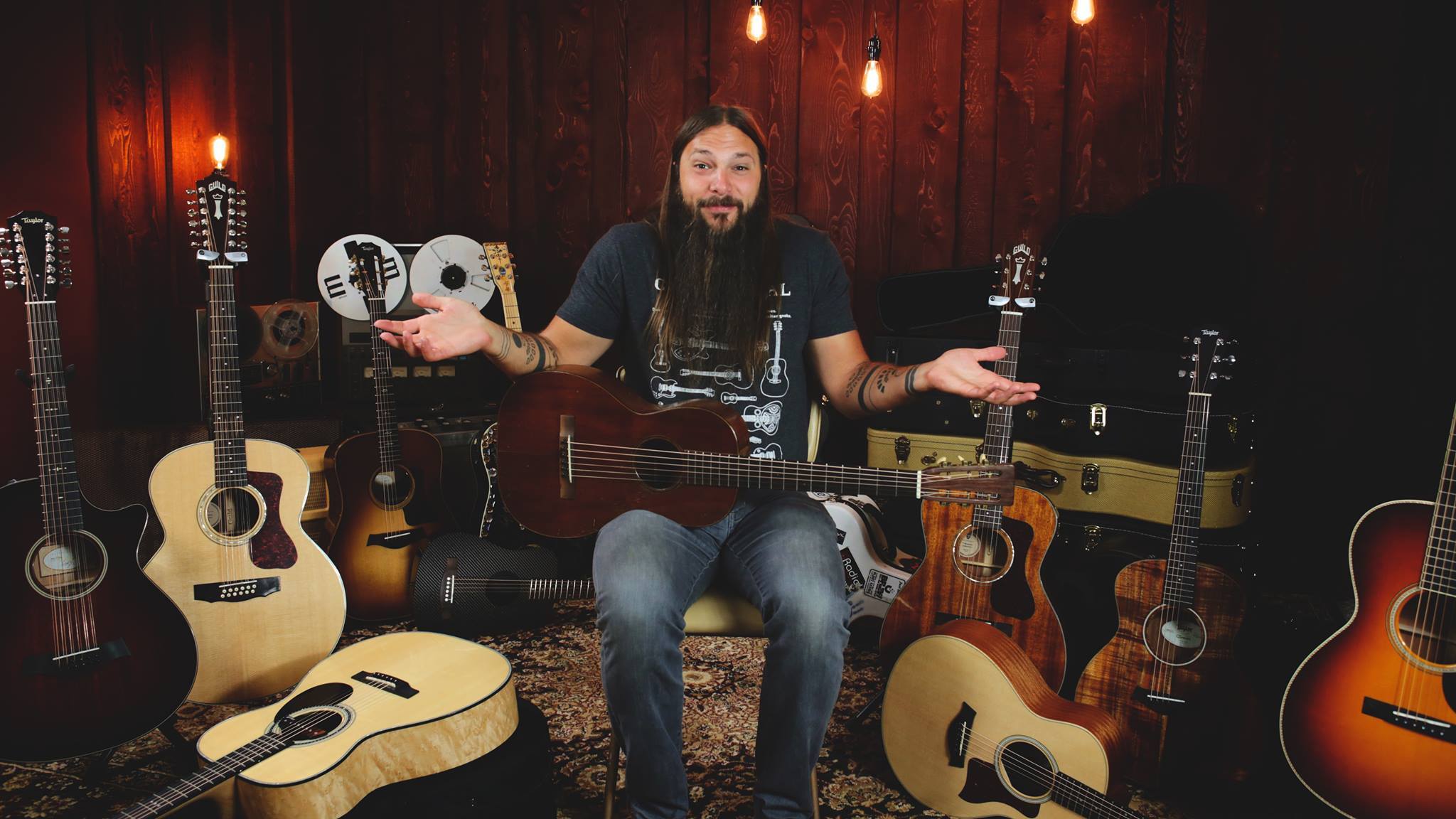
652.1K
Downloads
318
Episodes
Guitar playing tips and inspiration to play guitar consistently, have more fun and see more progress with your guitar routine. Every week your host, Tony Polecastro (from tacguitar.com) shows you a new guitar lick and shares new guitar gear and acoustic guitar music he‘s recently found. Tune out the overwhelm of online guitar lesson noise and let Tony be your guide to focus, fun and progress every Tuesday at 10am.
Episodes

Tuesday Apr 07, 2020
137- Taylor VS Martin: The Definitive Showdown
Tuesday Apr 07, 2020
Tuesday Apr 07, 2020
★ All show notes and links: https://acousticlife.tv/at137
★ Get the show: https://tonypolecastro.com/get-acoustic-tuesday
In this episode of Acoustic Tuesday, I'm doing the MOST COMPREHENSIVE comparison of Taylor Guitars and Martin Guitar. I've interviewed Bob Taylor, Chris Martin IV, and Andy Powers; I've seen factory tours, played dozens of models, read tons of books, and now...I'm ready to end this debate once and for all.
In order to give you the most holistic, the most comprehensive review of these two iconic guitar companies, I've broken things down into SEVEN categories: history, sustainability, manufacturing, standard model lineup, innovation, custom shop, and artist roster.
Beyond just looking at individual Taylor guitars and Martin guitars, this definitive guide for Taylor vs. Martin will shed light on topics no-other video has discussed.
I can't wait to hear your thoughts in the comments and I do hope you let me know how I did on evaluating each category in regards to Taylor vs. Martin.
For those of you short on time, here's a quick overview of each category...
Round 1: History
Martin takes the cake on this. As one of the oldest, continuously-run, family-run businesses in America. They built instruments during the Civil War, have survived economic crashes and depressions, and innovated the entire time.
Martin: 1
Taylor: 0
Round 2: Sustainability
At first glance, Taylor seems like the clear winner. With the sustainable harvest and cutting board company, Taylor has made big strides. However, Martin hasn't been slacking off. Martin's Smartwood Series is extremely sustainable. But what separates these two is Taylor's near-zero wood waste in their manufacturing process. Hat's off to Taylor. Be sure to watch my interview with Bob Taylor!
Martin:1
Taylor:1
Round 3: Manufacturing
I've visited both the Taylor and Martin factories. The sheer level of precision and craftsmanship — on a MASSIVE scale — is awe-inspiring. I was impressed by each one of these companies for their manufacturing efforts, for their ability to produce a high volume of high-quality instruments. But, I have to say...Taylor takes the cake in this category. Be sure to catch my explanation and tour of the Taylor factory to see why...
Martin: 1
Taylor: 2
Round 4: Model Offerings
For this category, I wanted to make sure that both Taylor and Martin have a wide variety of model offerings. I want to see everything from beginner guitars to performance guitars. Now, since Martin Guitars has been around for hundreds of years, they have almost too many offerings. Meanwhile, Taylor has a much more streamlined approach to their guitar models, each one with specific appointments and tonewood specifications. For this reason...Taylor wins this category. Watch the full video to see why.
Martin: 1
Taylor: 3
Round 5: Innovation
Let's think about this one...Martin created the dreadnought guitar, made the 14-fret neck, and introduced the X-bracing pattern. Martin essentially designed the guitar that we know and love today. Meanwhile, Taylor created V-class bracing to great success, created a new neck bracing, and designed and developed the ES-2 pickup. All that being said, I think this is a tie.
Martin: 2
Taylor: 4
Round 6: Custom Shop
I've made custom guitars using both the Martin custom shop and the Taylor custom shop. Both experiences were downright amazing, and I loved each one. While I designed two guitars, one from each shop, there was only one guitar that I truly wanted...and that was the Martin. Be sure to watch the video to see why Martin won this category.
Martin: 3
Taylor: 4
To see what I have to say about the Artist Roster for Taylor guitars and Martin Guitars, watch the full episode of Acoustic Tuesday!

Tuesday Mar 31, 2020
136 - Tony Rice's 6 Guitar Influences (Joni Mitchell, Clarence White)
Tuesday Mar 31, 2020
Tuesday Mar 31, 2020
★ All show notes and links: https://acousticlife.tv/at136
★ Get the show: https://tonypolecastro.com/get-acoustic-tuesday
Tony Rice is one of the most important bluegrass guitarists in history. Why? On today's episode of Acoustic Tuesday, I'm answering that question in the best way I know how: by playing the 6 degrees of Tony Rice.
The thing is, the best way to understand Tony Rice's impact is to look at his influences, to see how much he borrowed and blended to create some unforgettable music.
Now, I'd feature Tony Rice's covers on this episode of Acoustic Tuesday, but copyright laws be darned, I can't. So, instead, I'll feature other covers of the songs that Tony Rice covered!
If you want links to the actual Tony Rice covers, be sure to head to www.acousticlife.tv/at136
To kick things off, let's talk about the 6 most influential guitar players in Tony Rice's music.
6) Clarence White
From his flatpicking to owning his actual guitar, Tony Rice was heavily influenced by Clarence White. Tony Rice went as far as owning the exact Martin D-28 that Clarence White owned. Now, for those of you who don't know Clarence White was a member of The Kentucky Colonels, The Byrds, and many more bands. As you listen to Clarence White, you can absolutely hear how the rolling flatpicking sounds influenced Tony Rice.
5) Tom Paxton
For those of you who don't know, Tom Paxton is an incredible songwriter. Paxton led the charge on the folk revival. Born in Chicago, he relocated to New York City and frequented the Gaslight Cafe. Tony Rice pays homage to Tom Paxton by covering "The Last Thing on My Mind," on Church Street Blues. If you listen to the acoustic tone and song selection, Tom Paxton was a huge influence on Tony Rice.
4) Jim Croce
In 1994, Tony Rice covered Jim Croce's "Age" on the Bluegrass Band Vol. 4 album. Now, besides this album featuring some of the best musicians out there, Jim Croce's influence on Tony Rice is apparent. And, while I can't feature the Croce original or Rice's cover, I can show you Seth Avett's cover of "Operator," so be sure to listen to it today!
3) Ian Tyson
Ian Tyson is a huge influence on Tony Rice. In fact, Tony Rice covered his song "Summer Wages" not once but twice. The time Tony Rice covered it was on Native American and the second time was on J.D. Crowe and the New South's self-titled album. If you haven't heard that album, you need to hear it!
2) Joni Mitchell
In Tony Rices 1992 album Native American, he covered Joni Mitchell's gentle seasonal ballad "Urge for Going." Now, if you haven't heard the original, I highly recommend it. The lyrics are great, the phrasing is fantastic, and I love Joni's voice. All of this is to say that Tony Rice definitely tried to borrow from Joni Mitchell's lyricism. To help illustrate it and show the profound impact that Joni Mitchell had on the scene and how it further influenced Tony Rice, I've featured a clip of Dave Van Ronk covering "Urge for Going."
1) Gordon Lightfoot
The first degree of influence, of course, is Gordon Lightfoot. Lightfoot's influence on Tony Rice can be seen in his songwriting, flatpicking, and overall style and tone. See, Lightfoot led the charge on the folk revival in Canada. As such, Tony Rice actually dedicated an entire album to Gordon Lightfoot.

Tuesday Mar 24, 2020
135 - 5 Best Bluegrass Guitars Under $300
Tuesday Mar 24, 2020
Tuesday Mar 24, 2020
★ All show notes and links: https://acousticlife.tv/at135
★ Get the show: https://tonypolecastro.com/get-acoustic-tuesday
We're on a guitar budget this week. That's why I'm picking 5 of the BEST bluegrass guitars that are under $300. No matter what you're experience level is, you're going to be shocked by how good these guitars sound, so stay tuned for some fun surprises!
Before we go any further, I just want to say how grateful I am for this community — for those of you who watch Acoustic Tuesday every week, the ones who celebrate their guitar geekiness, the ones who play their guitars no matter the circumstances.
I am so grateful to be a part of this community. Seeing everyone come together over their mutual love and camaraderie towards the guitar is inspiring, motivating, and uplifting. So, thank you for being here and I hope to see you again soon!
/////
Now, for the 5 guitars for under $300...
5) Yamaha FG-800
What used to be the Yamaha FG-700S, the FG-800 is a bargain of a guitar. After some improvements in both bracing and top wood, this guitar for under $300 is a showstopper. This solid top dreadnought comes in at $199 and is powerful and phenomenal. It's durable, reliable, and is a great guitar to have around. When I worked in sales, I'd recommend this guitar to players of all experience levels just because it was such a good bargain.
4) Fender CD60S
A guitar similar to the Yamaha FG-800, the Fender CD60S is a great deal. I especially like this guitar because it comes with so many essential guitar "gadgets" like a strap, capo, case, and tuner. Besides that, the guitar has a solid top and plays smoothly. The standout note on the Fender CD60S is that it offers a slimmer neck profile, which works perfectly for folks with smaller hands. If you want to flex your style muscles, this guitar also comes in black.
3) Bristol BD-16
I was confused by this guitar at first. The Bristol BD-16 is an all-laminate guitar, and it's more expensive than the solid top Fender and Yamaha — coming in at around $250. How could that be? Fortunately, when I started listening to this guitar I understood its slightly higher price. The Bristol BD-16 is also incredibly durable. If you're not a fan of maintenance, humidity tracking, or want to play in the outdoors, this is a great guitar for that.
2) Alvarez AD-60S
This guitar is the real deal. It's got the aesthetics, a solid top, forward-shifted scalloped bracing, binding around the top, and an abalone rosette. I really love this guitar as an entry point into getting something that will last years and still sound great. Coming in at just under $300, I've had great experiences with this guitar and highly recommend it to anyone looking for a guitar on a budget.
1) Takamine GD20-NS
Why did I make the Takamine GD20-NS my #1 pick? It offers a completely different tone from all of the other guitars. That's because the Takamine GD20-NS is made with a solid cedar top. This allows the guitar to have a warm, woody, and delicate tone. For those of you who have a lighter touch, this guitar is for you. It's got volume, punch, and a delicate tone. Coming in at $299, I highly recommend this guitar if you like a lighter-sounding guitar.
Now, there are many more guitars that are under $300, so be sure to leave a comment if you know of any more bluegrass guitars for under $300.
★ Request your invite to Tony's Acoustic Challenge today: https://tonypolecastro.com/al-request-invite/?ref=INVITE&src=AL
★ All show notes and links: https://acousticlife.tv/at135
★ Get the show: https://tonypolecastro.com/get-acoustic-tuesday

Tuesday Mar 17, 2020
134 - How the Gibson Hummingbird Changed the World
Tuesday Mar 17, 2020
Tuesday Mar 17, 2020
★ All show notes and links: https://acousticlife.tv/at134
★ Get the show: https://tonypolecastro.com/get-acoustic-tuesday
The Gibson Hummingbird is one of the most iconic guitars in the world. From it's breathtaking design to its innovative construction, there's an aesthetic and comfortable quality that is unmatched by other guitars. Find out why everyone from Billy Joe Armstrong to Keith Richards plays the Gibson Hummingbird.
This entire episode is dedicated to talking about the Gibson Hummingbird. I want to celebrate one of the most eye-catching guitars and talk about alternatives that still hold up to the Gibson Hummingbird.
To start this Hummingbird themed episode, I want to talk about the TOP 5 reasons why you should at least consider playing a Gibson Hummingbird.
Reason #1: All current Gibson Acoustics are made right here in Bozeman, MT
Now, I'm currently living in Bozeman, so there's a little bit of a bias, but I still think this is significant. The Bozeman factory has a very high standard for production, especially when making as many guitars as they do!
Supporting the local economy and builders/technicians in my community is always a plus. Be sure to watch the episode to see the inside look at Gibson's Bozeman factory!
Reason #2: Gibson's flagship square-shouldered dreadnought is the Gibson Hummingbird
Before 1960, there wasn't a Gibson square-shouldered dreadnought that was mass-produced. Martin seemed to dominate the market prior to 1960, but when the Gibson Hummingbird came out, it changed the market forever.
Differing from Martin's square-shouldered models, the Gibson Hummingbird had pizzazz and a completely different aesthetic look that has captured the hearts of guitarists for the last 50 years. When you pick up a Gibson Hummingbird, you're holding history...and I think that can't be ignored.
Reason #3: Aesthetics Trifecta
After talking about the square-shouldered design, I realized that the Gibson Hummingbird really captures an aesthetic trifecta. What do I mean by that?
The first thing that makes the Gibson Hummingbird a beautiful and balanced guitar in its looks is the split parallelogram inlays on the neck. The contrast between the classic, rigid lines of the inlay on the smooth rosewood neck is just awesome to look at.
The second notable visual quality on the Gibson Hummingbird is the cherry burst top. The color of the Hummingbird's top is unmistakable, copies widely, and is absolutely gorgeous.
The third quality that completes the trifecta is finely engraved pickguard. There's a little bit of a hippy-vibe, a country-vibe, and a nod to the beauty of the natural world. There are very few guitars that are so clean, classic, and iconic.
Reason #4: Comfort
You might have heard about the scale length of the Gibson Hummingbird, but if not, just now that this guitar is incredibly comfortable and suitable for players of all sizes.
The first thing that makes the Gibson Hummingbird is the scale length. The scale length is 24 3/4 inches as opposed to 25 1/2 inches on other dreadnoughts. The Gibson Hummingbird also a very slim nut-width. This allows the string spacing to be smaller, accomodating small hands and fingers.
The final thing that makes playing the Gibson Hummingbird incredibly comfortable to play is a slim, tapered neck profile. For a guitarist with smaller hands that wants the sound of a big-bodied dreadnought, you can't go wrong with the Hummingbird.
Reason #5: The Birth of a Gibson Series
Think of the Gibson Hummingbird as the lead domino in a trend of Gibson guitars. To me, the Hummingbird kicked off Gibson's dedication to birds.
It all started in 1960 with the Gibson Hummingbird. From there, we move to the Gibson Dove. After that, there was the Gibson Doves in Flight, the artistic take on the Gibson Dove. After that, we moved to the Gibson Firebird acoustic with phoenix engravings. Then, we move to the Eric Church Hummingbird model. And that's just the acoustic guitars dedicated to birds!
There's a lot more that I talk about on this special episode of Acoustic Tuesday dedicated to the Gibson Hummingbird, so be sure to watch the full video or catch the show notes on acousticlife.tv today!
★ Request your invite to Tony's Acoustic Challenge today: https://tonypolecastro.com/al-request-invite/?ref=INVITE&src=AL
★ All show notes and links: https://acousticlife.tv/at134
★ Get the show: https://tonypolecastro.com/get-acoustic-tuesday

Tuesday Mar 10, 2020
133 - Why You Need a Martin D18 AND a Martin D28
Tuesday Mar 10, 2020
Tuesday Mar 10, 2020
➜All show notes and links: https://acousticlife.tv/at133/
➜Get the show: https://tonypolecastro.com/get-acoustic-tuesday
Nearly eight years later, I'm revisiting the Martin D18 and the Martin D28. These two iconic acoustic guitars are getting my full, undivided attention. I'll cover why these two guitars should be in your guitarsenal, famous players who use them, and 5 excellent alternatives.
To kick things off, I want to cover why the Martin D18 and the Martin D28 should be in your guitar collection. There are tons of reasons why these two iconic Martin acoustic guitars need to be in your collection, but I distilled it down to my top 5 reasons.
Reason #1: The Martin D18 and Martin D28 are EXTREMELY versatile.
There's almost no musical situation where a Martin D18 or D28 hasn't been used. Think about it. These guitars are mostly associated with bluegrass, but these guitars work for almost any genre. To prove it, I've got proof of singer-songwriters, rockers, and trad players using Marin D18s and D28s!
Reason #2: The Martin History
What's remarkable about owning a Martin guitar, especially a D18 or D28, is the history. When you play one of these guitars, you are stepping into history.
Starting in 1916, the dreadnought shape was created. After that, there have been twists and turns that have defined and shaped how this iconic body shape (pun intended) came to be. The dreadnought is a historical guitar shape that Martin absolutely innovated.
Reason #3: The Bass on Martin D18s and D28s
For guitars that have unmatched bass quality, regardless of whether they are vintage or not, look no further than the Martin D18 and D28. Now, just to be clear, each of these guitars has a slightly different bass sound, but the bass levels are truly awesome.
For example, the D18 offers a nice dry and woody bass tone. Meanwhile, the Martin D28 has a wonderful mid-scooped present bass tone. To demonstrate these differences, I have footage of Billy Strings and Molly Tuttle playing both Martin D18s and Martin D28s.
Reason #4: Martin D18s and D28s are the most imitated guitars on the market today.
I don't care what brand of guitar you choose, but they usually have a copy of the D18 and a copy of the D28. Why? Because the recipe is ingenious. With the Sitka spruce top and the mahogany rosewood back and sides, it's an unbeatable combo.
For those of you who recognize that Martin D18s and D28s are expensive, and perhaps are looking for the best imitations, look no further than this list of guitars:
1) Blueridge BR-140 (D18)
2) Blueridge BR-160 (D28)
3) Recording King RD-318 (D18)
4) Recording King RD-328 (D28)
5) Eastman Guitars E6-D (D18)
6) Eastman Guitars E8-D (D28)
Reason #5: The Martin D18 and D28 are used as standards for other guitars.
In my decade of reviewing guitars professionally, I've compared countless guitars to the Martin D18 and the Martin D28. Why?
Both the Martin D18 and the D28 are so finely crafted, that they have become the gold-standard for a well-crafted guitar.
/////
Now that you know why you need a Martin D18 and a Martin D28, I want to feature Sturgill Simpson, a proud user of Martin dreadnoughts like his custom Martin D18.
Now, I love that he uses a Martin HD28 and a custom D18...but can we talk about his voice for a little bit?
When I listen to Sturgill Simpson sing, he has a classic country quality that I don't hear that much these days. Additionally, his lyrics are masterful, ranging from sorrowful to comical all in just one song.
Be sure to check out Sturgill Simpson and listen to some of his music!
//////
Now, I know I mentioned some good alternatives to a Martin D18 or a Martin D28 earlier in the episode. However, I want to revisit this topic to give you a more focused list of specific guitars.
#3 for D18 Alternative: The Bourgeois Country Boy
For a guitar that has the same dry bass and projection that the Martin D18 has, the Bourgeois Country Boy is a strong contender. I've been playing this guitar for a while now, and I love how punchy that bass sound can be at times. It never seems to drown itself out or get too muddy, which I also appreciate.
Be sure to catch the full clip of me playing the Bourgeois Country Boy is to see if this D18 alternative stacks up to your expectations.
#3 for D28 Alternative: Boucher BG-52
Clocking in at my third-favorite non-Martin D28, the Boucher BG-52 is a stellar guitar from a stellar guitar maker. I've had the most recent experience with this guitar, and I truly believe this guitar can hold its own against a Martin D28. It has the open, voluminous sound as a D28 with maybe just a hair brighter tone.
To catch the full list of alternatives to the Martin D18 and the Martin D28, be sure to watch the full episode and visit Acoustic Life today for links and more!
★ Request your invite to Tony's Acoustic Challenge today: https://tonypolecastro.com/al-request-invite/?ref=INVITE&src=AL
★ All show notes and links: https://acousticlife.tv/at133
★ Get the show: https://tonypolecastro.com/get-acoustic-tuesday

Tuesday Mar 03, 2020
132 - How John Fahey Changed Acoustic Guitar Forever
Tuesday Mar 03, 2020
Tuesday Mar 03, 2020
➜All show notes and links: https://acousticlife.tv/at132/
➜Get the show: https://tonypolecastro.com/get-acoustic-tuesday
Ever heard of John Fahey? Ever wondered why you should be listening to John Fahey? In this episode, I'm covering the life of John Fahey and giving you 10 guitarists that are heavily influenced by John Fahey and preserving a uniquely American art form!
To understand how influential John Fahey is, we need to talk about American primitive guitar, a subgenre of folk/acoustic music. With one foot in blues and the other in country, American primitive guitar — founded by John Fahey himself! — was deeply percussive and focused on fingerpicking.
If you want to understand how Fahey's influence is still being felt today, be sure to check out this list of acoustic artists who borrow heavily from Fahey's style.
#10: Glenn Jones
#9: Jack Rose
#8: Nathan Bowles
#7: Rob Noyes
#6: Marisa Anderson
#5: Daniel Bachman
#4: Nathan Salsburg
#3: Jan Morgenson
#2: Joost Dijkema
#1: Gwenifer Raymond
Each one of these artists is building on John Fahey's legacy.
To get the links to each of the songs featured in this episode of Acoustic Tuesday, be sure to visit https://acousticlife.tv/at132/
Throughout this week's John Fahey show, I'll also be discussing 10 little known facts about John Fahey's life.
If you're interested in the life of one of the most influential but little known acoustic guitar players of all time, be sure to watch the whole episode of my list of 10 John Fahey Facts!
★ Request your invite to Tony's Acoustic Challenge today: https://tonypolecastro.com/al-request-invite/?ref=INVITE&src=AL
★ Get the show: https://tonypolecastro.com/get-acoustic-tuesday

Tuesday Feb 25, 2020
131 - 4 Guitar Mistakes (Music Theory?)
Tuesday Feb 25, 2020
Tuesday Feb 25, 2020
➜All show notes and links: https://acousticlife.tv/at131/
➜Get the show: https://tonypolecastro.com/get-acoustic-tuesday
Making one of these mistakes can set you back weeks or months (years?!) when learning guitar. Check out this episode of Acoustic Tuesday to make sure you're not making any of the 4 guitar mistakes regarding music theory.
I'm also featuring a BRAND NEW Boucher BG-52, incredible Acoustic Tuesday Artist Jon Gomm is going to answer your questions, and finally, you'll hear about a once-in-a-lifetime opportunity to visit Ireland and the Emerald Guitar factory.
Now, back to the 4 music theory mistakes that most guitar players make...
Mistake #1: You don't think you're ready.
This can happen to ANY guitar player. Professionals, beginners, and everyone in between. I gotta say, you're always ready to learn some music theory.
The fact is, when you start to learn theory, it's going to accelerate your progress. Whether you've been playing for a week or a year, learning theory will make your progress that much faster. You'll be making connections that will make everything make sense.
Mistake #2: You need a comprehensive understanding of music theory.
If you think you have to understand everything about music theory, from composition to harmony to modes, you're dead wrong.
I mean, it's nice to know these things, but the bottom line is that you don't need to know everything to play guitar.
Instead, you should target the 20 or 10% of music theory that will help you every day on your guitar journey.
Mistake #3: You don't have enough time.
Instead of learning theory, you think that you should just play the songs and scales you already know...right?
Here's the funny thing...when you start learning music theory, you learn other concepts faster. In the short window of time you have to work on your guitar playing and music, if you incorporate music theory, you can have lightbulb moments left and right.
Mistake #4: You have self-doubt.
There's no easy way to talk about self-doubt. As a guitarist, you're putting yourself out there, and it takes a lot out of you.
Whether you're playing with friends, at an open-mic night, or posting a song to TAC or YouTube, remember that you can do it!
Learning music theory is no different. You can do it. Don't let your self-doubt take control of the situation. Whether you're brand-new to guitar or coming back after years off, learning music theory can truly change how you practice and play guitar. You got this!
Now, if you noticed that you're making any of these mistakes, I want to tell you about something special...
On March 1st, I'm starting my Fretboard Wizard Challenge — a course that focuses on the bare essentials of music theory (specifically for guitar players!).
To learn more about my Fretboard Wizard Course, visit https://fretwiz.com

Tuesday Feb 18, 2020
130 - Why Barre Chords Are Worth the Pain
Tuesday Feb 18, 2020
Tuesday Feb 18, 2020
➜All show notes and links: https://acousticlife.tv/at130/
➜Get the show: https://tonypolecastro.com/get-acoustic-tuesday

Tuesday Feb 11, 2020
129 - Learn THIS Scale (know them all)
Tuesday Feb 11, 2020
Tuesday Feb 11, 2020
➜All show notes and links: https://acousticlife.tv/at129/
➜Get the show: https://tonypolecastro.com/get-acoustic-tuesday

Tuesday Feb 04, 2020
128 - How to Find Any Note On Guitar (2 Tricks)
Tuesday Feb 04, 2020
Tuesday Feb 04, 2020
➜All show notes and links: https://acousticlife.tv/at128/
➜Get the show: https://tonypolecastro.com/get-acoustic-tuesday
